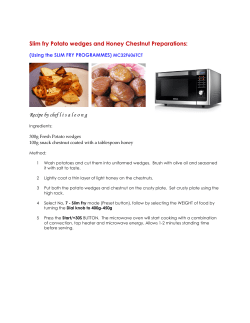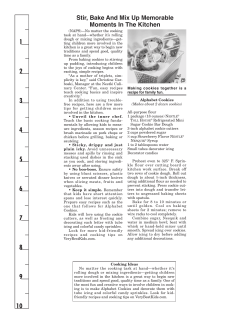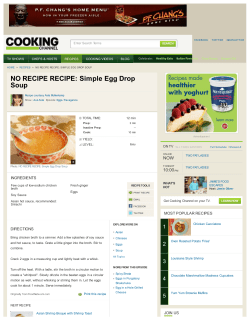
Cooking 101 Cooking in Small Spaces Using a Microwave Oven (Week 7)
FN1618 ) 7 k e (We Cooking 101 Quick and Easy Menus, Recipes and Tips for Singles and Couples Cooking in Small Spaces Using a Microwave Oven North Dakota State University, Fargo, North Dakota August 2012 When deciding what to make for dinner, people usually consider taste, cost and convenience. Even if you have little time for meal preparation or live in a location with minimal cooking space, you still should consider nutrition. Proper nutrition provides the nutrients and energy we need to stay healthy, and with just a few tips and suggestions, you can prepare and eat nutritious and satisfying foods in most living situations. Pop What do you know already? 1 Quiz: (The answers are on Page 4.) True or False: You can heat foods in takeout containers, old whipped topping bowls or margarine tubs in a microwave oven. 2 When using this cooking method, you should stir the food halfway through and rotate the cooking dish to eliminate uneven cooking temperatures or cold spots: a) Baking b) Grilling c) Microwaving d) Heating on the stovetop 3 Which one of these dishes is not microwave safe? a) Glass bowl b) Plastic foam cup c) Ceramic bowl d) Bowl labeled microwave safe 2 Cooking 101: Week 7 www.ndsu.edu/eatsmart Tips for Savin g Space n Compa re unit pric es of differe smaller co nt sizes of ntainer do foods. If th es not cos the smalle e t considera r size may bly more, b be a good space. uying way to sav e cupboard n Get rid of unneces sary cookw keep migh are. Some t include a essentials frying pan measuring to , sauce pa cups, spatu n, slow co la and othe often. oker, r equipme nt you use n Plan we ekly menu s consideri and what is ng what yo on sale at u have on the grocery groceries y hand store. Buy ou need fo only the r the week . n When p lanning yo u r m enus, cons cooked in ider which a limited s foods can pace with single pan be a slow coo . ker, microw ave or n Take ad vantage of leftovers b Consider ta y eating th king them em the ne to work or xt day. school in a n Be crea small coole tive to max r. imize the s your toaste pace you h r on top of ave. Can y your micro dishes in y ou store wave? Can our slow c you store s ooker whe frying pan mall n it is not in and sauce use? Will y pans all ne o u r st in one s n If you d tack? o not have a lot of refrig vegetables erator spa and fruits in ce, buy ca stead of fr provide gre nned esh. Cann at nutrition ed version , and you c temperatu s still a n store the re. m at room n Wash d ishes after each meal. make your Leaving ou kitchen fee t dir ty dish l more cra that impac es will mped and t your entire can create living spac access to odors e. If you do a space to not have wash dish consider u e s with warm sing dispo , soapy wa sable pape ter, r products . Cooking 101: Week 7 www.ndsu.edu/eatsmart 3 Which Containers Are Microwave Safe? Safe for microwave use: n Glass, ceramic cookware and those labeled safe for microwave use n Microwave-safe plastic wraps, wax paper, cooking bags, parchment paper and white microwave-safe paper towels Not safe for microwave use: n Margarine tubs, whipped topping bowls, cheese containers and other disposable plastic containers because they melt from increased temperatures, which causes harmful chemicals to get into your food n Carry-out containers from restaurants or plastic foam (unless they specifically state microwave safe) n Foam-insulated trays and plastic wraps on fresh meats from grocery stores Note: Discard containers that hold prepared microwavable meals after you use them because they are meant for one-time use. Answers: 1. False, 2. c, 3. b 4 Cooking 101: Week 7 www.ndsu.edu/eatsmart “Cook It Safe!” When Microwaving n Know what wattage your microwave is and compare that to the wattage stated in the packaged food’s cooking directions. The lower the wattage, the slower the microwave cooks your food, so adjust cooking times accordingly. n Read and follow package cooking directions. n Be sure to arrange food items evenly in microwave-safe dishes and add water if needed. You can cover any dish with a lid or plastic wrap before cooking to help keep in moisture. n Defrost and cook large cuts of meat and other frozen foods on medium power (50 percent) rather than high power (100 percent); this allows heat to reach the center without overcooking outer areas. When defrosting food, use 30 percent power or the defrost setting on the microwave. n Stir and rotate your food half way through cooking to prevent cold spots or areas where harmful bacteria can survive. n Prevent burns by removing your food from the microwave carefully. Use potholders and uncover foods away from your face so steam can escape. n Observe recommended “standing time.” The “stand time” means the food continues to cook to a higher temperature after it’s removed from the microwave. n Use a food thermometer to be sure your food is cooked to the proper temperature. *For more information on safe cooking tips for a microwave, check out www.fightbac.org. Key to Abbreviations tsp. = teaspoon Tbsp. = tablespoon c. = cup oz. = ounces pkg. = package g = grams mg = milligrams lb. = pound Recipes Microwave Meatloaf 1/3 c. rolled oats 1 egg, slightly beaten 1 clove garlic, minced 1/3 c. finely chopped onion 1 (8-oz.) can tomato sauce, no sodium 1/8 tsp. pepper 11/2 lbs. lean ground beef or pork 1/4 c. ketchup Mix oats, egg, garlic, onion and pepper. Crumble ground beef into mixture and blend thoroughly. Press into 9- by 5-inch loaf pan (microwaveable) and cover loosely with paper towel. Microwave on high seven minutes, rotate pan and microwave seven more minutes. Rotate once more and microwave five more minutes or until internal temperature reaches 160 degrees. Spread with ketchup and recover loosely with paper towel. Microwave at medium (50 percent) until ketchup is heated, two to three minutes Makes eight servings. Per serving: 140 calories, 4.5 g fat, 18 g protein, 7 g carbohydrate, 1 g fiber, 140 mg sodium Meal idea: wave Baked ro eatloaf*, Mic ad, Microwave M slices, whole-wheat bre le Potato*, app ee or low-fat milk fat-fr uded *Recipe incl Cooking 101: Week 7 www.ndsu.edu/eatsmart 5 Microwave Sweet Potato or Baked Potato 1 Medium-sized sweet potato or Russet potato Scrub the outside of the potato with a vegetable brush under cool running water to remove dirt. Puncture a few times with a fork to allow the steam to escape. Place the potato on a paper towel in a microwave-safe dish. Cook on high for six to seven minutes. Turn over and rotate the potato half way through cooking. Variations: -Top baked potato with veggies, cheese, chili or whatever else you would like. -Top sweet potato with a little cinnamon and sugar or salt and pepper. Sweet Potato - Makes one serving. Per serving: 150 calories, 0 g fat, 2 g protein, 38 g carbohydrate, 4 g fiber, 70 mg sodium Potato - Makes one serving. Per serving: 160 calories, 0 g fat, 4 g protein, 36 g carbohydrate, 4 g fiber, 20 mg sodium Microwave Scrambled Eggs 1 egg 1 Tbsp. milk or water Spray glass bowl or other microwave-safe dish with nonstick spray. Add milk or water and egg, blending lightly with fork. Cover with plastic wrap and cook for 30 to 45 seconds for one egg. Remove from microwave; stir. Cover and let stand two to three minutes. Season to taste. Variations: -Add onions, peppers or other vegetables before microwaving to add color and flavor to your eggs. -Sprinkle with cheese or top with salsa after taking the eggs out of the microwave. Makes one serving. Per serving: 70 calories, 5 g fat, 6 g protein, 70 mg sodium Meal idea: -wheat bled Eggs, whole Microwave Scram free or low-fat milk toast, banana, fat- 6 Cooking 101: Week 7 www.ndsu.edu/eatsmart Tex-Mex Chicken and Beans Salad 1 (10-oz.) can chunked chicken, drained 1 (15- to 19-oz.) can red kidney beans, no salt, drained 1 (4-oz.) can green chilies, chopped, drained 1/2 c. hot taco sauce 1 c. Monterey Jack and/or Cheddar cheese, shredded 1 large tomato, diced 1 bag of chopped romaine lettuce In 10-inch round baking dish or other microwave-safe dish, combine chicken, beans, chilies and taco sauce. Cook, covered with plastic wrap, on high five to seven minutes until heated through, stirring once. Toss lettuce, tomatoes and cheese, then dish salad and top with the chicken mixture. You also could top with salsa, onions and sour cream if desired. Makes six servings. Per serving: 200 calories, 8 g fat, 18 g protein, 14 g carbohydrate, 3 g fiber, 470 mg sodium Meal idea : Tex-Mex Chicke n and Beans S al whole-wheat b read, orange sl ad, ic es, low-fat or fatfree milk Cooking 101: Week 7 www.ndsu.edu/eatsmart 7 Microwave Chicken Tortilla Soup 1 (14-oz.) bag whole-kernel corn, frozen 1 (15-oz.) can black beans 1 (15-oz.) can kidney or cannellini beans 1 (14.5-oz.) can diced tomatoes, no sodium 1 (4-oz.) can green chilies, chopped, drained 1 (14.5-oz.) can chicken broth, low sodium 1 (10-oz.) can chunked chicken 1 (10-oz.) can cheddar cheese soup (reduced fat and/or sodium) Optional toppings: Crushed tortilla chips, shredded cheese, diced tomatoes Meal idea: Microwave Chicke n Tortilla Soup, side salad, whole-wheat brea d, strawberries, fat-free or low-fat milk Open all the cans. Drain and rinse beans in a strainer. Place all ingredients in a large microwave-safe bowl and cover with plastic wrap. Cook on high for 18 minutes, stirring three times or until chicken is heated through. Serve. Alternate directions: Place in a large pot on the stove and heat thoroughly. Refrigerate leftovers. Use to top baked potatoes, pasta or rice. Or freeze in meal-sized portions if you will not use the leftovers within three days. Makes 10 servings. Per serving: 170 calories, 4 grams (g) fat, 13 g protein, 22 g carbohydrate, 5 g fiber and 520 milligrams sodium Julie Garden-Robinson, Ph.D., R.D., L.R.D., Food and Nutrition Specialist Casey Kjera, Student Dietitian Heather Wisness, Extension Agent (former) Eat Smart. Play Hard. Together. For more information, visit www.ndsu.edu/eatsmart. The NDSU Extension Service does not endorse commercial products or companies even though reference may be made to tradenames, trademarks or service names. NDSU encourages you to use and share this content, but please do so under the conditions of our Creative Commons license. You may copy, distribute, transmit and adapt this work as long as you give full attribution, don’t use the work for commercial purposes and share your resulting work similarly. For more information, visit http://www.ag.ndsu.edu/agcomm/ creative-commons. For more information on this and other topics, see www.ag.ndsu.edu County commissions, North Dakota State University and U.S. Department of Agriculture cooperating. North Dakota State University does not discriminate on the basis of age, color, disability, gender expression/identity, genetic information, marital status, national origin, public assistance status, race, religion, sex, sexual orientation, or status as a U.S. veteran. Direct inquiries to the Vice President for Equity, Diversity and Global Outreach, 205 Old Main, (701) 231-7708. This publication will be made available in alternative formats for people with disabilities upon request, (701) 231-7881 .?M-7-12
© Copyright 2025





















